How To Grow Your Search Ranking By Bootstrapping SEO

Hand off the toughest tasks in SEO, PPC, and content without compromising quality
Explore ServicesLet me lay it straight: SEO is hard in 2020.
And frankly, it was never easy. Maybe back in 2010, when Google could be tricked with keyword stuffing, PBNs, and various other methods like message board posts used for backlinks. There was also a lot less competition.
These days, basically all keyword clusters and niches are taken by well-known sites and they can be hard to outrank. Especially for a smaller site like mine, with a lower budget, trying to bootstrap my SEO.
I like to consider myself lucky because the transcription industry has many niches, which opens possibilities for keyword research and content creation. I’ve gone through trial and error with bootstrapping my SEO for years now, and it’s taken this long to get to where I am today.
I think the key takeaway from this post is that anyone can bootstrap their SEO. You don’t need a large budget, and you can do it yourself as long as you have some patience and are willing to learn.
What Does Bootstrapping SEO Mean?
SEO has 3 main categories: keyword research, content, and backlinks.

Working on these three main categories is what makes your search engine ranking grow.
If you don’t know how to work on these areas yourself, you’ll likely hire an SEO guy to do it for you.
Did you know that hiring someone to take care of your SEO isn’t cheap? Most SEO projects in 2020 cost between $750 and $2,000 per month. A one-time project can burn a $5,000-$30,000 dollar hole in your budget!
So, what if you’re like me, without a huge budget to spend on SEO? Most of the income Transcription Outsourcing makes goes to paying hard-working staff and other expenses like rent, office supplies, and everything else that a transcription company needs.
Hiring someone to do our SEO would mean compromising other areas of the business. And that’s precisely why I’ve adopted the bootstrapping SEO strategy.
And by bootstrapping SEO, I mean getting the highest ROI with the lowest budget.
Bootstrapping SEO is doing it yourself, with little or no investment other than your time. It’s an excellent self-sustaining way of growing your SEO for your business’s benefit.
Bootstrapping SEO is hard. Like anything in SEO, you won’t see immediate results.
In the next part, we’ll focus on the 3 components of SEO and how to bootstrap them.
Keyword Research
If you’ve been in the SEO game for a while now, you know keywords are the foundation of SEO.
Simply put, keyword research allows you to create content around what people are searching for. If you create content randomly, you won’t get much traffic from Google.
It appears that not enough websites have a solid keyword research strategy. Ahrefs says 90.63% of all pages in their index don’t receive any organic traffic.

Keyword research can help you answer important questions like how hard it will be to rank for that keyword, who your direct competition is, how much traffic you can get for that keyword, and how many conversions you might receive.
When you know the answers, you can decide whether it’s worth going after that keyword or not, which can save you a lot of time when you’re trying to bootstrap SEO.
Focus on Long-Tail Keywords
Throughout my bootstrapping strategy, I’ve realized that putting the focus on finding long-tail keywords has been the most rewarding.
Long-tail keywords are keywords or more specific key phrases, and usually longer than more commonly searched for keywords.
An example of a long-tail keyword phrase is “how do you transcribe a legal document,” whereas a keyword is “transcription services.”
Long-tail keywords get less traffic overall, and usually have higher conversion value, as they are more specific. It is much easier to rank for long-tail keywords because there is less competition.
You could even include the location for local SEO in your long-tail keyword. Location specific keyword phrases are often people who know what they want and where they want it and are ready to buy whatever it is they are searching for. For example, “transcription services for legal agencies in Denver.” This brings the competition way down as it is so specific.
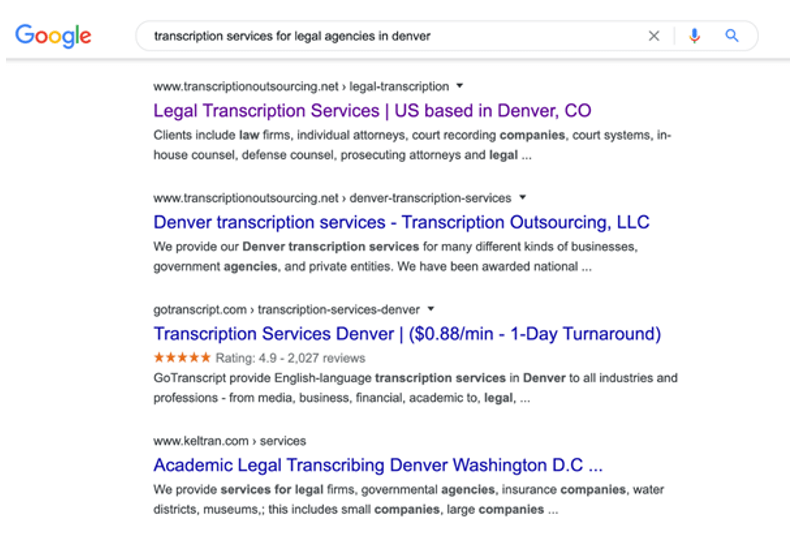
Long-tail keywords attract traffic that knows what they are looking for and are most likely already on the buyer’s journey. Remember, bootstrapping is about getting the highest ROI with the lowest budget.
How to Piece Your Long-Tail Keywords
The first step to piecing long-tail keywords is to determine your head theme. Food blogs are usually about eating and restaurants. Dog blogs are all about breeds and food brands. Our blog is about transcription and transcription related topics.
Your site or blog’s main topic or theme is what you want to use as your head theme and first keyword. It’s how people will find you. In our case, it’s transcription.
Next comes the tail topics. These are anything more specific that stay directly related to the head theme. Let’s take the “transcription services for law firms” as an example. The keyword “transcription” acts as an anchor, and we can choose several long-tail variants to follow.
- Transcription services in the medical industry
- Transcription services for classroom lectures
- Transcription services for the hard of hearing or deaf
- Transcription services companies in Colorado
The list goes on. You will find all of these keywords if you have done your keyword research right. We’ll see more on this in the section below.
Where to Find Keywords
Looking for keywords that send traffic to your competitors is a great place to start when doing keyword research.
The most efficient and cost-effective way to search for your competition begins on Google. Surprise! You don’t need to pay for a keyword research tool for this. Type your head term into the search bar and analyze the first page. These are more than likely your direct competitors.

From here, I like to use the competitor analysis with Ahrefs to see the competitor’s most popular pages by search traffic and each page’s top keyword. I get enough keywords to make content for months.
Analyzing competitors can give you a great source of keyword ideas.
What if there are keywords your competitors aren’t targeting?
You can also find these secret gems using keyword research tools.
Google Keyword Planner is probably the best if you’re trying to bootstrap your SEO as it’s free and works well. Enter a few head terms and see what pops up.
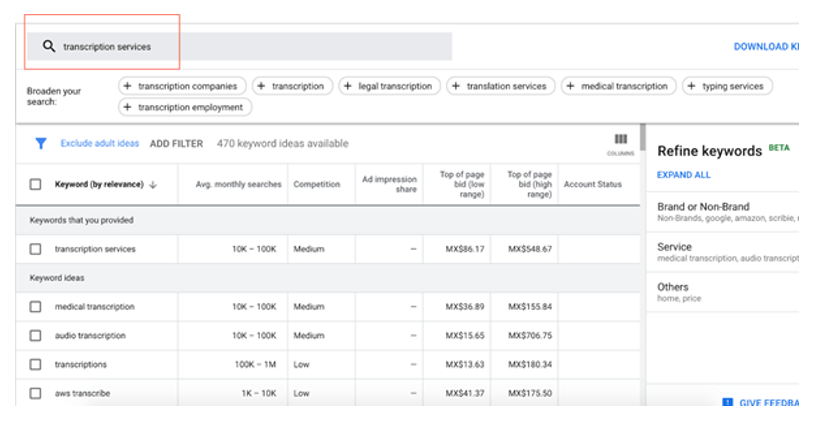
There are free tools besides Google Keyword Planner. If you’re trying to get a TON of keyword ideas all at once, Keyword Sheeter is another favorite of mine.

Once you enter a keyword, it keeps loading more and more of them. I got 202 results from entering the keyword “transcription services.”
Other free keyword tools for your bootstrapping SEO strategy include Google Trends, Keyword Generator, Answer the Public, Google Search Console, and the list continues.
One thing many people overlook is simply using Google suggestions.
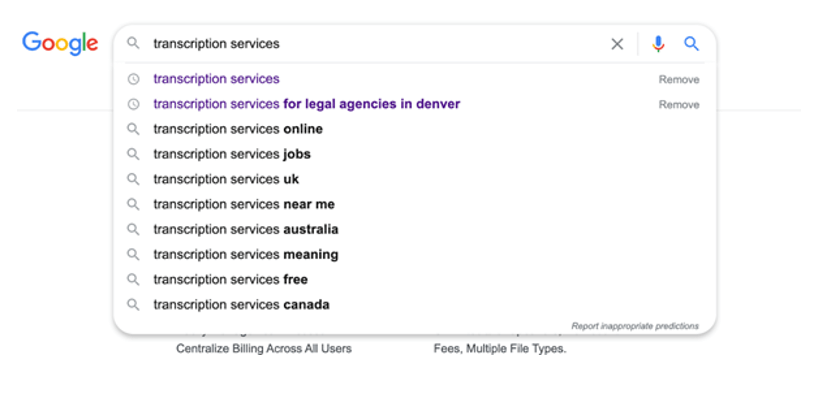
Type your keywords into the search bar and see what comes up. These are all commonly searched for keywords.
Another way is to input your keyword in the search bar like you would for any other Google search. Press enter then scroll to the bottom of the page to the “searches related to” section.

Searching Google can be done even before you look for a keyword tool. It’s fast, and the suggestions are accurate.
After years of working in the field, if you’re like me, you know the ins and outs of your niche. You may be able to pick keywords to aim for without having to do research. You’ll rely on your knowledge of the industry and the lingo that is specific to each niche.
Your customers may hint keywords as well. If the same questions have been popping up over and over again within your clientele base, it may be time to create some content around those questions they keep asking.
Content
Once you have the keywords, you can write the content.
It’s important to be aware that it’s not the quantity of content you have that matters. It’s quality. Pumping out several 800-word blog posts per week won’t get you anywhere with SEO. Focus on creating long-form content that adds up to 2,000-3,000 words. There are plenty of blogs out there with 50 or so killer blog posts and are reaching their SEO wildest goals.
Through my time running a blog, I’ve realized that the content I put a lot of energy in is what ends up ranking and getting more traffic.
Why? Because there’s no more space on the internet for generic content. And, content is one of the main factors in Google’s algorithm.
There’s a word being thrown around the SEO community called 10X content. It basically means your content should be 10 times better than anything else out there.
Here’s exactly what goes into 10X content:
- Combine high quality, trustworthy, exciting, original, useful, and remarkable material. It doesn’t need to be all of these. A combination of a couple is good.
- Create an emotional response. The reader wants to feel awe, complete, surprise, admiration, or any other emotion you want the reader to feel.
- Include trustful sources to educate and inform the reader.
- Original to everything your competitors have made for the same search intent.
- Visually appealing, including images and videos.
- User-friendly for all devices.
If you can check all of the boxes, you’ve got yourself a piece of 10X content.
One more thing to note is that Google likes long sessions and low bounce rates. Include videos, embedded forms, podcasts, social share buttons, or anything that makes the user stay on your site longer.
A great way of keeping visitors longer is by making “ultimate guides.” This type of pillar post is more likely to get linked back to hundreds of times. They are long, extremely useful, thorough, and there’s lots of space to include visuals and examples.
Brian Dean, Backlinko Founder, created a massive pillar post on all things SEO marketing. It’s long, thorough, there are a ton of links, images, examples, headings, and spot-on information.
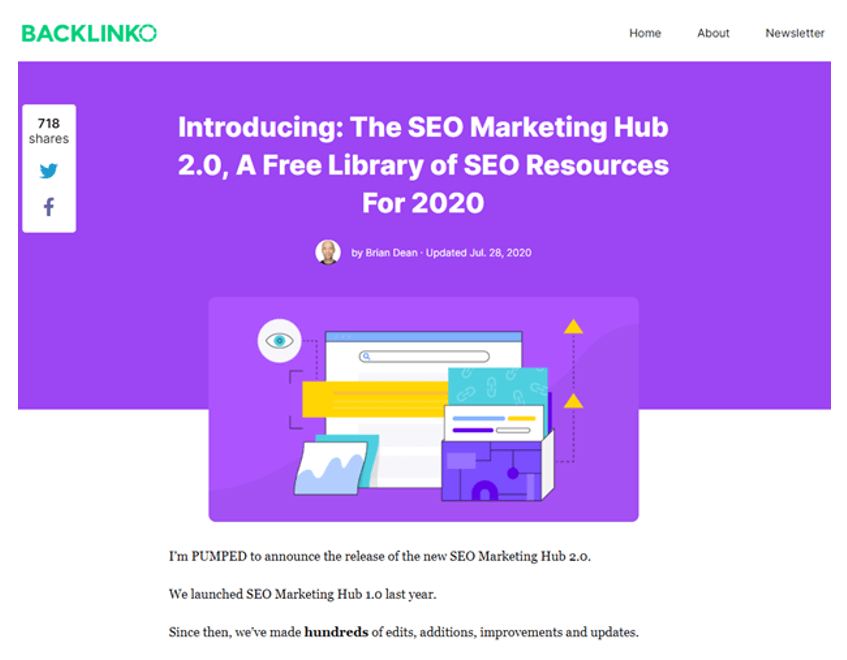
It’s so massive and so useful that it gets a whopping 216K visits PER MONTH. That’s a lot, especially if your page is full of calls to action. There’s major potential for gaining traffic and reaching massive conversions, increasing your ROI and getting the best out of your bootstrapping strategy.

10X content is an SEO strategy that’s easy to bootstrap if you have time to write the content yourself. Things can get expensive when you need to hire writers. Especially because hiring writers for $15 per article isn’t going to cut it when you’re aiming for content as good as Neil Patel’s.
Good writers who can deliver all of the aspects that go into 10X content generally charge by the word. A 2,000-word article can easily cost $200 or more, depending on the experience and rate of the writer.
If you genuinely want to bootstrap your SEO, make sure to organize time to write and publish at least one 10X article per week.
Backlinks
To make your 10X content rank, you need backlinks. Backlinks from authoritative sites are a signal to search engines like Google that others vouch for your content and your content is worth bringing up in the rankings.
The best part of link building is that it fits perfectly into a bootstrapping SEO strategy — it’s free.
Here are some of the ways to get backlinks:
- Guest posting on blogs/podcasts
- SEO outreach
- PR campaigns
- Links from customers
- Forums and comments
Some backlinks are far more valuable than others. Links from trustworthy, authoritative, popular, and quality blogs are considered the best places to ask for backlinks.
On the other hand, private blog networks, duplicate content, poor quality guest posts, and foreign language websites are links that should be avoided as Google may see them as spammy.
Did you know that the back links you receive on your website also differ in value and affect SEO? The same applies when you are spreading link juice, the websites you choose to link out to (even the anchor text you use, whether you choose the follow or nofollow link, and any meta tags you associate with the linking page) from your site can heavily impact your site’s value.
The importance of backlinks is up there with keyword research and content.
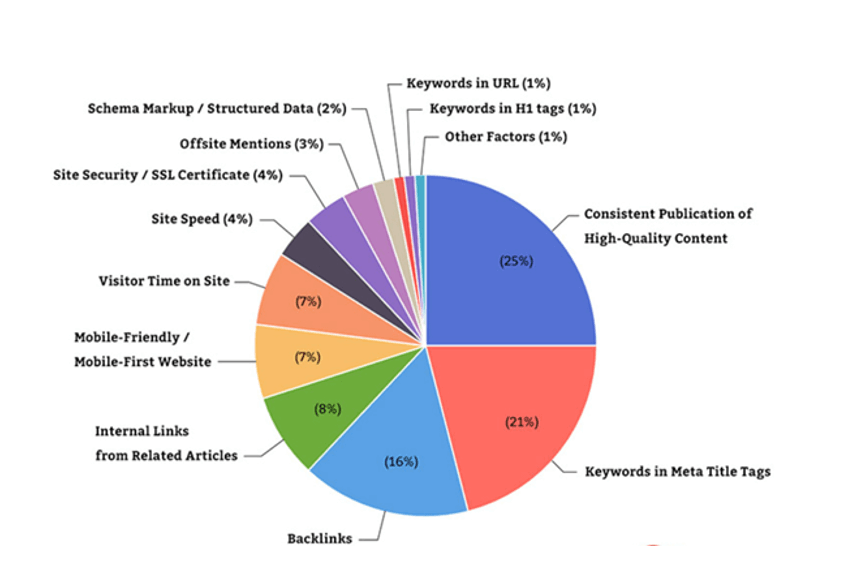
Link building takes time, and not every blog you reach out to will accept your offer.
My preferred way to get backlinks is by guest posting. There are a ton of blogs that accept guest posts on a weekly basis. Guest posting gives me more exposure, and I am able to create a piece of content, or a resource, that will be on the internet forever. It’s truly the most rewarding type of backlink.
How do you reach out for guest posts? Websites often have a “guest post guidelines” right in their menu bar. Here’s an example on Loganix’s website:

Some websites don’t include this kind of information and it doesn’t mean they don’t accept guest posts. They may want you to reach out personally.
What happens if you don’t know their email or who to contact? I’ve used Hunter.io a number of times to find emails.
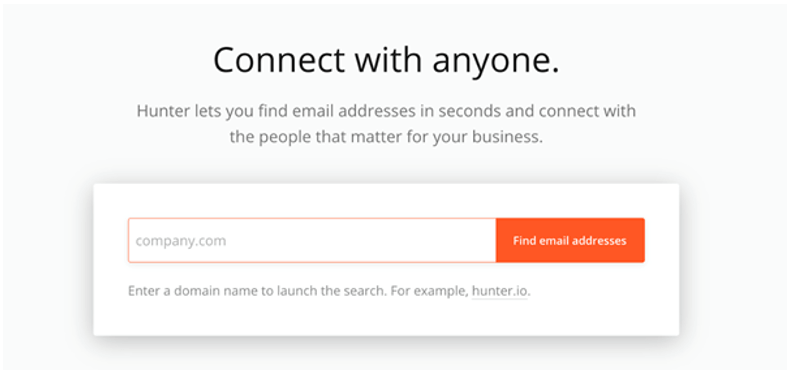
It’s another great tool that you should include in your bootstrapping SEO strategy to get guest post opportunities or do backlink outreach.
Conclusion
Bootstrapping SEO is not an easy feat. It takes effort, knowledge, and a lot of time. There are so many ways to grow your SEO even if you don’t have any connections, resources, or money. It’s a matter of putting your mind to it and understanding that if you make the right decisions, bootstrapping your SEO will become your new favorite way of growing your blog’s SEO. The tips in this article should get you started. Your success from here on really depends on how much you want to succeed.
PS: If you want to bootstrap your SEO, you need to know how to do SEO in the first place. When I was starting out, I didn’t know anything. Unfortunately, blogs don’t always answer specific questions or give the best support. I joined Traffic Think Tank, an SEO community that runs through Slack. It costs $119/month and it is so worth it. I’ve learned all sorts of things there and even hired a writer that was recommended to me on the platform.

Like-minded people from all over the world help each other out with any SEO related questions, recommendations, and advice you can imagine. It’s like having a tutor available for your most difficult class 24/7. Better yet, it’s like having the cheat codes to your favorite game, except it’s not cheating because it’s all white hat SEO information on TTT.
Hand off the toughest tasks in SEO, PPC, and content without compromising quality
Explore ServicesWritten by Ben Walker on September 9, 2020
Ben Walker is a CEO, entrepreneur, and visionary leader that enjoys helping others become successful in business and in life. Ben’s company Transcription Outsourcing provides user friendly and cost-effective transcription services for the medical, legal, law enforcement, and financial industries for organizations all over the world. Ben is a sought after thought leader and has made contributions to publications like Entrepreneur Magazine, Inc, Forbes, and the Associate Press. Follow Ben’s Tweets: @benjaminkwalker





